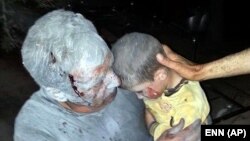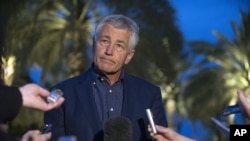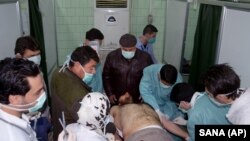WASHINGTON —
The United States now says there is evidence that chemical weapons may have been used in the Syrian civil war, and a debate is underway over what President Barack Obama’s administration should do about it.
The president said last week the evidence points to small-scale use of chemical weapons. Intelligence officials said the evidence pointed to the poison gas, sarin, a powerful nerve agent said to be 500 times more toxic than cyanide that can kill those exposed in less than a minute. Officials in Britain and France say they have come to similar conclusions.
But U.S. and allied officials also said it was unclear how much sarin may have been used and who actually used it. Syria is known to possess large stores of chemical weapons, including sarin, but questions remained over whether its use was officially sanctioned by the government of Syrian President Bashar al-Assad.
The issue was especially difficult for Obama because he said in August of last year that systematic use of chemical weapons against civilians in Syria would be a “game changer” that would bring about a shift in Washington’s policy of non-intervention. The president now says more detailed information is needed before any change in policy.
The evidence so far
Gregory Koblenz, a nuclear and biological warfare specialist at the Council on Foreign Relations, says the chemical warfare allegations are based on two basic forms of evidence from Syria, neither of which alone provides enough information about what really happened.
“One is video footage of alleged chemical attacks in Syrian hospitals,” he told VOA. “Some of the symptoms we see are consistent with exposure to a nerve agent like sarin, but the problem is that there are other chemicals that can cause similar reactions, and just the videos alone don’t provide enough information and context to really assess what happened to these people.”
There has also been mention of soil and human tissue samples that have been taken out of Syria and analyzed by labs in the United States and Britain. But Koblenz says these samples are also unreliable.
“The provenance is murky, and that raises questions about whether these samples are really from the location they are said to be taken from, whether they were tampered with along the way, whether they stored properly to preserve the signatures within the samples to provide a useful analysis,” Koblenz said.
In other words, simply finding sarin in soil doesn’t prove who used them.
Doctors’ Claims
Dr. Zaher Sahloul of Chicago, president of the Syrian-American Medical Association, has just returned from his sixth mission in Syria, where he spoke with medical personnel in seven hospitals in and around Aleppo.
“In the six or seven attacks that we spoke to physicians about, they all reported similar symptoms. And these attacks happened in Homs in December of last year—that was the first reported one—and then we [had] two in Aleppo. The largest one was on March 19th in the area of Khan al-Asal, and there were about 40 people who died and more than 300 who were admitted to the hospitals for symptoms. Some of them ended up on the ventilator in the ICU (intensive care unit),” he said.
Sahloul said all these patients were reported to have symptoms “consistent with cholinergic syndrome,” which is usually caused by drug overdose, eating certain poisonous mushrooms or exposure to nerve gas or certain pesticides.
“So the patients had respiratory and neurologic symptoms—respiratory, including shortness of breath, bronchospasm, a lot of secretion and respiratory failure requiring mechanical ventilation, large concentration oxygen—and also neurologic symptoms, confusion, convulsions, and some of them went into comas—and also eye symptoms,” he said.
Sahloul said the only other chemical agent that could cause similar symptoms would be certain insecticides, which he rules out in this case. “It’s very unlikely that in these six or seven areas you had exposure to insecticides, especially since everyone reported a similar pattern: That you have an explosion, usually a missile, usually from a fighter jet or from a helicopter, and then people see white smoke, and then they start to have symptoms. It’s very unlikely that you have this related to exposure to insecticide,” he said. “Other less harming agents like tear gas and chlorine, for example, will not cause neurologic symptoms, will not cause death."
Implications and Options
Joel Rubin, director of policy and government affairs for the Washington D.C.-based Ploughshares Fund, says that before the Washington can consider taking any action, it must understand exactly what happened in Syria.
“It appears there was some dispersement of sarin, but we need to understand where that came from. Was it part of a structured decision; was there a use of it in a manner that would actually suggest it will continue to be used?” he said. “That would create a certain set of reactions.”
Rubin says the bigger question is exactly how the West, Russia and China should react and adds that all possible options pose serious consequences.
“Syria sits next to key allies of the United States—Jordan, Turkey, Lebanon, Israel and Iraq,” Rubin said. “What happens in Syria matters to those neighbors, so should the U.S. and Western countries, the U.N., try to create buffer zones, humanitarian corridors or buffer zones around the borders to ensure that those countries are not destabilized?”
Some U.S. politicians are calling on the White House to begin arms shipments to selected elements of the Syrian opposition. But Rubin points out that the rebels, some of whom have been identified as terrorist groups, remain an unknown quantity.
Act Now
Gary Schmitt, co-director of the Marilyn Ware Center for Security Studies at the conservative American Enterprise Institute, however, believes Washington needs to act as soon as possible, even in the absence of definitive evidence of chemical weapons use.
“It’s rare that you ever get 100 percent certainty of the kind that the administration is saying that it wants right now, and that sort of chain of custody—i.e., who did what, who’s to be blamed—it’s rare that you get that kind of intelligence,” Schmitt said. “And if you use that kind of standard, what happens is that you delay making decisions, which in this case are really causing an immense amount of instability in the region, in addition to the loss of lives.”
Specifically, he thinks the United States should create a no-fly zone and a safe zone to harbor civilians. “And then—again this is not an easy thing to do—we ought to be able to define who it is in the Syrian opposition that we want to support and arm, with the idea that if we give them sufficient military assistance, [they] will flock to our side.”
If the U.S. doesn’t act, Schmitt fears that one of two things could happen: “Either the jihadis are going to wind up controlling what happens after Assad goes, or you’re just going to have an incredibly splintered situation in Syria which makes Beirut in Lebanon look like New Jersey.”
The president said last week the evidence points to small-scale use of chemical weapons. Intelligence officials said the evidence pointed to the poison gas, sarin, a powerful nerve agent said to be 500 times more toxic than cyanide that can kill those exposed in less than a minute. Officials in Britain and France say they have come to similar conclusions.
But U.S. and allied officials also said it was unclear how much sarin may have been used and who actually used it. Syria is known to possess large stores of chemical weapons, including sarin, but questions remained over whether its use was officially sanctioned by the government of Syrian President Bashar al-Assad.
The issue was especially difficult for Obama because he said in August of last year that systematic use of chemical weapons against civilians in Syria would be a “game changer” that would bring about a shift in Washington’s policy of non-intervention. The president now says more detailed information is needed before any change in policy.
The evidence so far
The provenance is murky, and that raises questions about whether these samples are really from the location they are said to be taken from, whether they were tampered with along the way, whether they stored properly to preserve the signatures within the samples to provide a useful analysis.Gregory Koblenz, a nuclear and biological warfare specialist at the Council on Foreign Relations,
“One is video footage of alleged chemical attacks in Syrian hospitals,” he told VOA. “Some of the symptoms we see are consistent with exposure to a nerve agent like sarin, but the problem is that there are other chemicals that can cause similar reactions, and just the videos alone don’t provide enough information and context to really assess what happened to these people.”
There has also been mention of soil and human tissue samples that have been taken out of Syria and analyzed by labs in the United States and Britain. But Koblenz says these samples are also unreliable.
“The provenance is murky, and that raises questions about whether these samples are really from the location they are said to be taken from, whether they were tampered with along the way, whether they stored properly to preserve the signatures within the samples to provide a useful analysis,” Koblenz said.
In other words, simply finding sarin in soil doesn’t prove who used them.
Doctors’ Claims
Dr. Zaher Sahloul of Chicago, president of the Syrian-American Medical Association, has just returned from his sixth mission in Syria, where he spoke with medical personnel in seven hospitals in and around Aleppo.
“In the six or seven attacks that we spoke to physicians about, they all reported similar symptoms. And these attacks happened in Homs in December of last year—that was the first reported one—and then we [had] two in Aleppo. The largest one was on March 19th in the area of Khan al-Asal, and there were about 40 people who died and more than 300 who were admitted to the hospitals for symptoms. Some of them ended up on the ventilator in the ICU (intensive care unit),” he said.
Sahloul said all these patients were reported to have symptoms “consistent with cholinergic syndrome,” which is usually caused by drug overdose, eating certain poisonous mushrooms or exposure to nerve gas or certain pesticides.
“So the patients had respiratory and neurologic symptoms—respiratory, including shortness of breath, bronchospasm, a lot of secretion and respiratory failure requiring mechanical ventilation, large concentration oxygen—and also neurologic symptoms, confusion, convulsions, and some of them went into comas—and also eye symptoms,” he said.
Sahloul said the only other chemical agent that could cause similar symptoms would be certain insecticides, which he rules out in this case. “It’s very unlikely that in these six or seven areas you had exposure to insecticides, especially since everyone reported a similar pattern: That you have an explosion, usually a missile, usually from a fighter jet or from a helicopter, and then people see white smoke, and then they start to have symptoms. It’s very unlikely that you have this related to exposure to insecticide,” he said. “Other less harming agents like tear gas and chlorine, for example, will not cause neurologic symptoms, will not cause death."
Implications and Options
Joel Rubin, director of policy and government affairs for the Washington D.C.-based Ploughshares Fund, says that before the Washington can consider taking any action, it must understand exactly what happened in Syria.
“It appears there was some dispersement of sarin, but we need to understand where that came from. Was it part of a structured decision; was there a use of it in a manner that would actually suggest it will continue to be used?” he said. “That would create a certain set of reactions.”
Rubin says the bigger question is exactly how the West, Russia and China should react and adds that all possible options pose serious consequences.
“Syria sits next to key allies of the United States—Jordan, Turkey, Lebanon, Israel and Iraq,” Rubin said. “What happens in Syria matters to those neighbors, so should the U.S. and Western countries, the U.N., try to create buffer zones, humanitarian corridors or buffer zones around the borders to ensure that those countries are not destabilized?”
...Again, this is not an easy thing to do—we ought to be able to define who it is in the Syrian opposition that we want to support and arm, with the idea that if we give them sufficient military assistance, [they] will flock to our side.Gary Schmitt, American Enterprise Institute
Act Now
Gary Schmitt, co-director of the Marilyn Ware Center for Security Studies at the conservative American Enterprise Institute, however, believes Washington needs to act as soon as possible, even in the absence of definitive evidence of chemical weapons use.
“It’s rare that you ever get 100 percent certainty of the kind that the administration is saying that it wants right now, and that sort of chain of custody—i.e., who did what, who’s to be blamed—it’s rare that you get that kind of intelligence,” Schmitt said. “And if you use that kind of standard, what happens is that you delay making decisions, which in this case are really causing an immense amount of instability in the region, in addition to the loss of lives.”
Specifically, he thinks the United States should create a no-fly zone and a safe zone to harbor civilians. “And then—again this is not an easy thing to do—we ought to be able to define who it is in the Syrian opposition that we want to support and arm, with the idea that if we give them sufficient military assistance, [they] will flock to our side.”
If the U.S. doesn’t act, Schmitt fears that one of two things could happen: “Either the jihadis are going to wind up controlling what happens after Assad goes, or you’re just going to have an incredibly splintered situation in Syria which makes Beirut in Lebanon look like New Jersey.”











